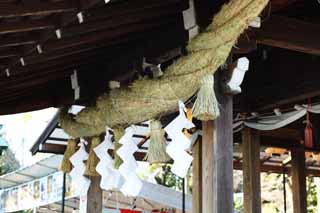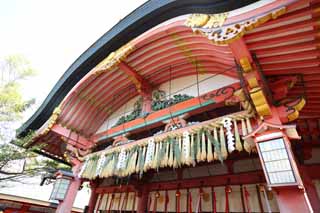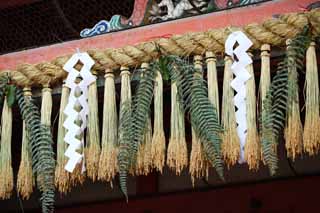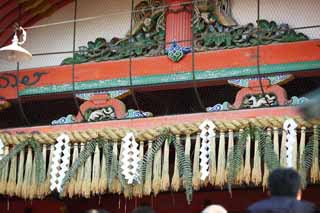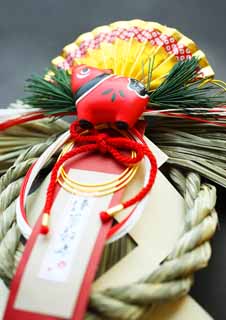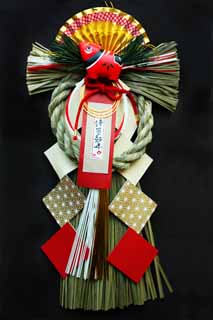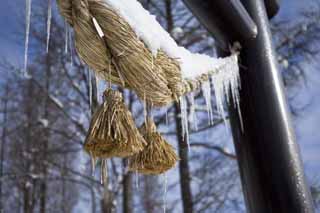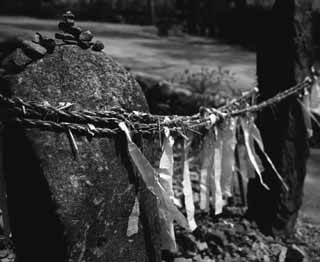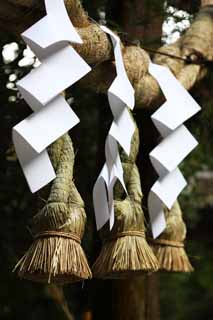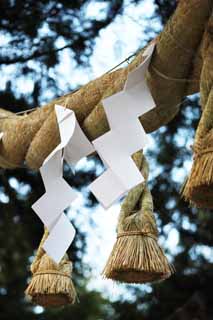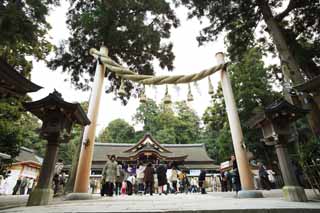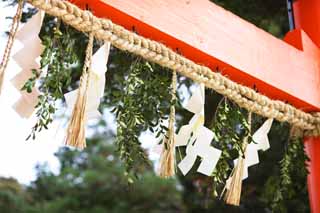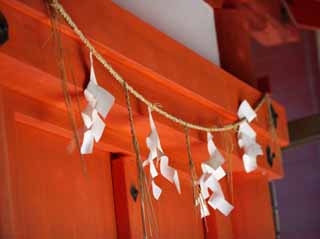Yun Free Stock Photos
keyword "a shinto straw festoon"
Images can be modified and be used for commercial purposes without fee under the license.
Next keyword "tower for the repose of souls"
Click the thumbnail to look.
Keyword Search in this Site
You can search the image by entering the keyword in the following box.

Custom Search
No.9211 A needle rope Shinto shrine
| It is the Shinto straw festoon of the needle rope Shinto shrine in the foot of Inuyama-jo Castle. A needle rope Shinto shrine is the first place plus needle rope Myojin and Shinto shrine. | |
| Camera: | Canon EOS-1Ds Mark III , SIGMA MACRO 70mm F2.8 EX DG |
|---|---|
| Location: | Japan / Aichi Prefecture |
| Size: | 5616 x 3744Pixels |
No.8710 Fushimi-Inari Taisha Shrine Shinto straw festoon
| It is the Shinto straw festoon of the main shrine of Fushimi-Inari Taisha Shrine of New Year holidays. Fushimi-Inari Taisha Shrine is total Hongu of Inari Shrine of national about 40,000 companies worshiping Inari God. It is an opening IrokonoHatanoKimi catches the Imperial command for 711 years in the Christian era, and to have worshiped each God in three peaks of the Mt. Ina profit (Inariyma). | |
| Camera: | Canon EOS-1Ds Mark III , EF 135mm F2L |
|---|---|
| Location: | Japan / Kyoto |
| Size: | 5616 x 3744Pixels |
No.8709 Fushimi-Inari Taisha Shrine Shinto straw festoon
| It is the Shinto straw festoon of the main shrine of Fushimi-Inari Taisha Shrine of New Year holidays. Fushimi-Inari Taisha Shrine is total Hongu of Inari Shrine of national about 40,000 companies worshiping Inari God. It is an opening IrokonoHatanoKimi catches the Imperial command for 711 years in the Christian era, and to have worshiped each God in three peaks of the Mt. Ina profit (Inariyma). | |
| Camera: | Canon EOS-1Ds Mark III , EF 135mm F2L |
|---|---|
| Location: | Japan / Kyoto |
| Size: | 5616 x 3744Pixels |
No.8707 Fushimi-Inari Taisha Shrine Shinto straw festoon
| It is the Shinto straw festoon of the main shrine of Fushimi-Inari Taisha Shrine of New Year holidays. Fushimi-Inari Taisha Shrine is total Hongu of Inari Shrine of national about 40,000 companies worshiping Inari God. It is an opening IrokonoHatanoKimi catches the Imperial command for 711 years in the Christian era, and to have worshiped each God in three peaks of the Mt. Ina profit (Inariyma). | |
| Camera: | Canon EOS-1Ds Mark III , EF 135mm F2L |
|---|---|
| Location: | Japan / Kyoto |
| Size: | 5616 x 3744Pixels |
No.6983 I occupy it and display it
| It is one of the decorations [I occupy it and display it] for Japanese New Year holidays (I close it and display it). Because it was the Year of the Ox, the red decoration which modelled a cow sticks for 2,009 years. I occupy it and decorate the decoration as a mark of the visits of god controlling a zodiacal year who reports happiness to the family for New Year holidays at the entrance. Originally it was the event of the festival to pray for staple grains abundant harvest. There are New Year's pine and bamboo decorations and a Shinto straw festoon, a round mirror-shaped rice-cake for a decoration elsewhere for New Year holidays. | |
| Camera: | Canon EOS-1Ds Mark III , SIGMA MACRO 70mm F2.8 EX DG |
|---|---|
| Location: | Japan / Tokyo |
| Size: | 3744 x 5304Pixels |
No.6982 I occupy it and display it
| It is one of the decorations [I occupy it and display it] for Japanese New Year holidays (I close it and display it). Because it was the Year of the Ox, the red decoration which modelled a cow sticks for 2,009 years. I occupy it and decorate the decoration as a mark of the visits of god controlling a zodiacal year who reports happiness to the family for New Year holidays at the entrance. Originally it was the event of the festival to pray for staple grains abundant harvest. There are New Year's pine and bamboo decorations and a Shinto straw festoon, a round mirror-shaped rice-cake for a decoration elsewhere for New Year holidays. | |
| Camera: | Canon EOS-1Ds Mark III , SIGMA MACRO 70mm F2.8 EX DG |
|---|---|
| Location: | Japan / Tokyo |
| Size: | 3744 x 5616Pixels |
No.3255 Is numb || occupy it, and is a rope
| Of a torii || occupy it, and a rope is full of ice, too. | |
| Camera: | Canon EOS-1Ds Mark II , SIGMA MACRO 50mm F2.8 EX DG |
|---|---|
| Location: | Japan / Hokkaido |
| Size: | 4992 x 3328Pixels |
No.744 Roped ritual enclosure
| A scene of the Korean Folk Village in the suburbs of Seoul | |
| Camera: | Canon EOS Kiss Zoom28-105mm |
|---|---|
| Location: | Republic of Korea / Seoul |
| Size: | 2188 x 1792Pixels |
No.7186 Omiwa shrine Shinto straw festoon
| It is Japanese oldest Nara Shrine, the middle shrine of the three-wheeled Shinto shrine, the Shinto straw festoon of the narrow well Shinto shrine. The three-wheeled Shinto shrine is a Shinto shrine worshiping Omiwa-jinja Shrine, master of big game Oga (the wolf of the thing master) which is called three-wheeled Myojin. It is an opening that the Emperor let you worship the big game chief god in B.C. 91 and regards Mt. Miwa itself as an object of worship (Mt. object of worship). | |
| Camera: | Canon EOS-1Ds Mark III , EF 135mm F2L |
|---|---|
| Location: | Japan / Nara Prefecture |
| Size: | 3744 x 5616Pixels |
No.7173 Omiwa shrine Shinto straw festoon
| It is Japanese oldest Nara Shrine, a Shinto straw festoon in front of the main shrine of the three-wheeled Shinto shrine. The three-wheeled Shinto shrine is a Shinto shrine worshiping Omiwa-jinja Shrine, master of big game Oga (the wolf of the thing master) which is called three-wheeled Myojin. It is an opening that the Emperor let you worship the big game chief god in B.C. 91 and regards Mt. Miwa itself as an object of worship (Mt. object of worship). | |
| Camera: | Canon EOS-1Ds Mark III , EF 135mm F2L |
|---|---|
| Location: | Japan / Nara Prefecture |
| Size: | 3744 x 5616Pixels |
No.7167 Omiwa shrine main shrine
| It is Japanese oldest Nara Shrine, the main shrine of the three-wheeled Shinto shrine. A big Shinto straw festoon works. The three-wheeled Shinto shrine is a Shinto shrine worshiping Omiwa-jinja Shrine, master of big game Oga (the wolf of the thing master) which is called three-wheeled Myojin. It is an opening that the Emperor let you worship the big game chief god in B.C. 91 and regards Mt. Miwa itself as an object of worship (Mt. object of worship). | |
| Camera: | Canon EOS-1Ds Mark III , Distagon 21mm F2,8 |
|---|---|
| Location: | Japan / Nara Prefecture |
| Size: | 5616 x 3744Pixels |
No.7138 Two Kamigamo Shrine toriis
| It is a world heritage of Kyoto, the Shinto straw festoon of two toriis of upper Kamo Shrine. Upper Kamo Shrine named an official name [god of thunder Corporation according to Kamo], and it was built for 678 years in the Christian era by the Emperor Tenmu. It is the deep Shinto shrine of the connection for the Imperial Family. | |
| World Heritage | Historic Monuments of Ancient Kyoto |
|---|---|
| Camera: | Canon EOS-1Ds Mark III , EF 135mm F2L |
| Location: | Japan / Kyoto |
| Size: | 5616 x 3744Pixels |
No.4459 The paper appendix of Kasuga Taisha Shrine
| It is a Shinto straw festoon and the paper appendix which can hang before a world heritage, the gate built between the main gate and the main house of the palace-styled architecture in the Fujiwara period of Kasuga Taisha Shrine of Nara. Kasuga Taisha Shrine moves Kashima God that (710 years), Fuhito Fujiwara are patron saints of Fujiwara on the Mikasa mountain of Kasuga for Wado three years and worships you and begins though I called myself Kasuga God. | |
| World Heritage | Historic Monuments of Ancient Nara |
|---|---|
| Camera: | Canon EOS-1Ds Mark II , EF 135mm F2L |
| Location: | Japan / Nara Prefecture |
| Size: | 4464 x 3328Pixels |
